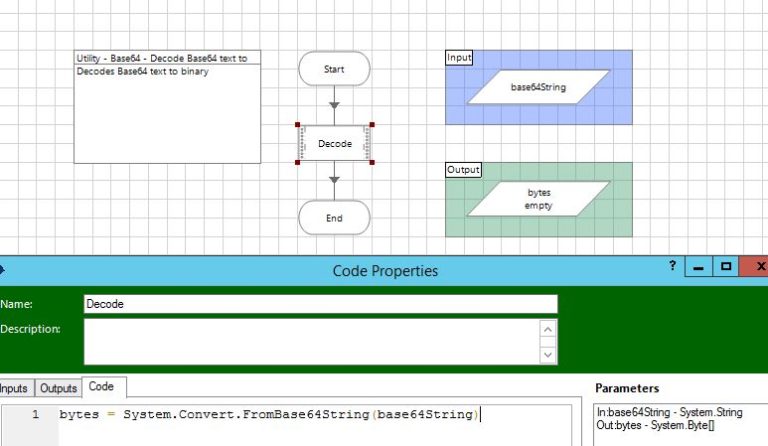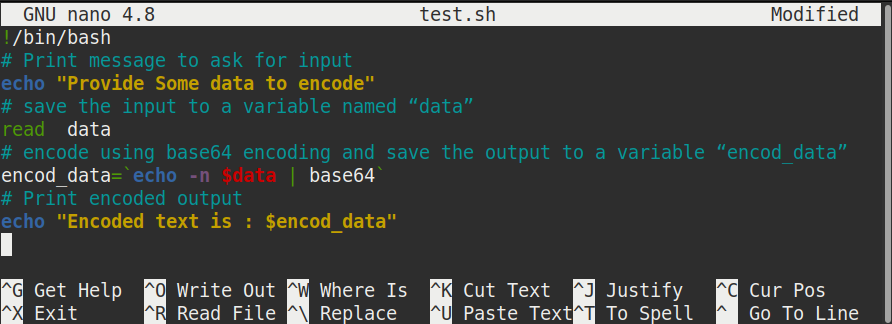

- #Command line decode base64 install#
- #Command line decode base64 code#
- #Command line decode base64 series#
- #Command line decode base64 windows#
You may also want to check out some of these parsers to test your system once AUOMS is installed. This means that if you put the nf file from the MSTIC-Research repo into the /etc/opt/microsoft/auoms/output.d directory and restart AUOMS it should start outputting to Syslog. If the version is 2.1.8 then it should include the Syslog output option. This will check if AUOMS running and reveal its version if it is.
#Command line decode base64 code#
Do this by running the following code from the terminal of the machine you want to test: Once you’ve installed AUOMS, you may want to check if the currently distributed version from Log Analytics/Azure Sentinel includes the Syslog output option by default. This blog covers the installation and troubleshooting options in detail, as well as how you can create a Log Analytics workspace.
#Command line decode base64 install#
You will need to install it on each host you’d like to collect data from in your Log Analytics workspace. It can also be used for other command line parsing, which you can explore through your own Jupyter Notebooks or through queries on Sentinel.ĪUOMS can be installed and set up through the Linux terminal. The MSTIC research branch of it can forward events to Syslog, which can be collected and accessed on Azure Sentinel (see this link for more information on collecting Syslog in Sentinel), making it a great option for collecting command line data and parsing it for Base64 encodings. It may be helpful to run the notebook yourself as you read through it.ĪUOMS is a Microsoft audit collection tool that can collect events from kaudit or auditd/audisp. This blog will walk you through the setup and use of this notebook. It then walks you through an investigation and scoring process that will highlight the commands most likely to be malicious, which can focus your investigation down to individual hosts and lead to further exploration using the Linux Host Explorer Notebook or any other tools and methodologies you prefer.

This notebook attempts to query for and analyze Base64-encoded commands found in execve logs in your Azure Sentinel workspace. A specific case of this is discussed and analyzed here. This is often seen in crypto mining attacks. This Guided Hunting: Base64-Encoded Linux Commands Notebook was created in response to an increasing number of attackers encoding their bash commands into Base64. Thus, we’ve been working on expanding coverage on Linux-specific investigations. Many of our Azure customers use Linux virtual machines, and we are always looking for ways to help our customers in their security investigations. Please note that all notebooks are live on Github and under revision so be aware that the notebooks you use might be slightly different from those described in blog posts.

These notebooks are all built using Microsoft Threat Intelligence Center’s Python API MSTICpy.
#Command line decode base64 windows#
Other notebooks you can access now are available on the Azure Sentinel Notebook Github and cover Windows host exploration, IP Addresses, Domains & URLs, Linux hosts, and much more. Here are links to Part 1, Part 2, and Part 3.
#Command line decode base64 series#
Base64-decodes data read from standard input and writes the result to standard output.A blog series written last year covers the use of Jupyter notebooks in threat hunting in more detail.Base64-decodes the data contained in the 'encoded-data.txt' file and writes the result to the 'raw-data.txt' file.īase64 decode decode -inputFile encoded-data.txt \.Base64-decodes the string 'SGVsbG8=' and writes the result to standard output.The following arguments cannot be used together: -data, -inputFile -addTrailingLineBreak - Add a line break to the end of the decoded data.-url - Decode the data with the base64url mechanism rather than the standard base64 mechanism.The specified path must refer to a file which may or may not exist, but whose parent directory must exist. If this is not provided, the decoded data will be written to standard output. -propertiesFilePath - The path to a file to which the decoded data should be written.-V / -version - Display version information for this program.-helpSubcommands - Display the names and descriptions of the supported subcommands.

-H / -help - Display usage information for this program.If it is absent from a set of arguments, then it will be assumed to have a value of 'false'. If this argument is included in a set of arguments, then it will be assumed to have a value of 'true'. This argument is not allowed to have a value. -interactive - Launch the tool in interactive mode.Jump to a list of the available subcommands. This tool uses subcommands to indicate which function you want to perform. The base64 Command-Line Tool The base64 Command-Line ToolĮncode raw data using the base64 algorithm or decode base64-encoded data back to its raw representation.


 0 kommentar(er)
0 kommentar(er)
